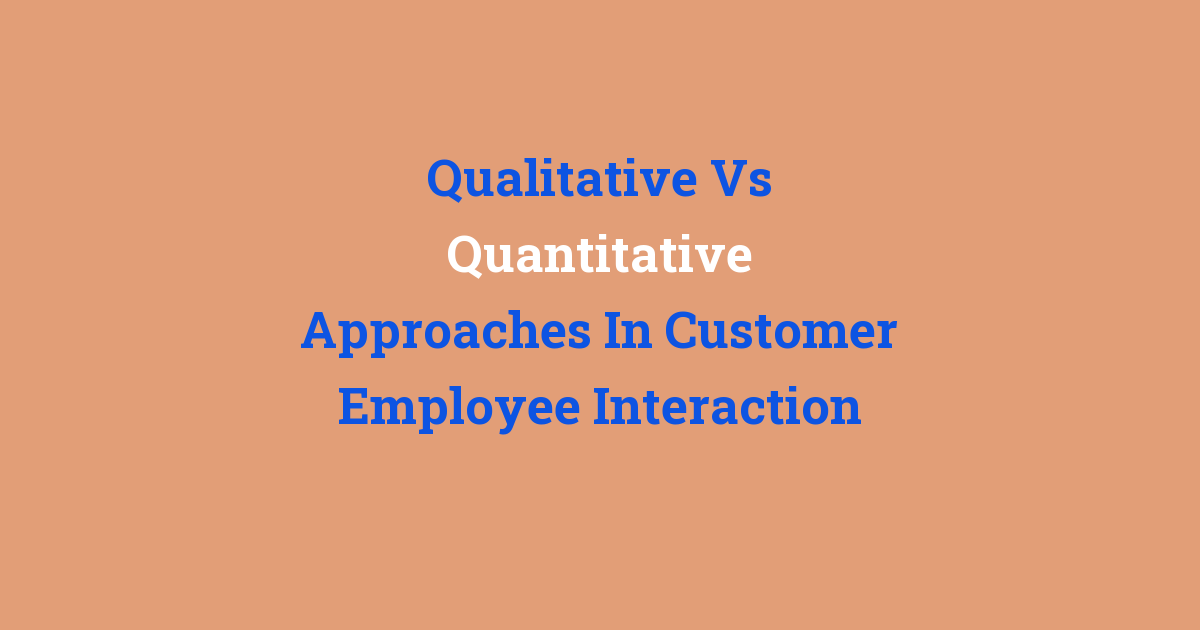Approaches to customer-employee interaction can be categorized as qualitative or quantitative.
Qualitative vs Quantitative Approaches in Customer Employee Interaction
Introduction
In the field of customer employee interaction, companies are constantly looking for ways to improve customer satisfaction and employee productivity. One important aspect of this is the approach companies take in collecting and analyzing data related to these interactions. Two common approaches are qualitative and quantitative research methods. In this report, we will examine the differences between these two approaches and discuss their advantages and disadvantages in the context of customer employee interaction.
Problem Statement
The problem that companies face in implementing a customer employee interaction system is determining the most effective way to collect and analyze data. Qualitative research methods involve collecting non-numerical data, such as customer feedback and employee surveys, and analyzing it to identify trends and patterns. On the other hand, quantitative research methods involve collecting numerical data, such as sales figures and employee performance metrics, and analyzing it to identify correlations and causation. The challenge for companies is determining which approach will provide the most valuable insights into customer employee interaction.
Existing System
In the existing system, many companies rely heavily on quantitative data to measure customer satisfaction and employee performance. This data is easy to collect and analyze, making it a popular choice for companies looking to make data-driven decisions. However, quantitative data only tells part of the story. It does not provide insights into the emotions and motivations behind customer and employee behavior. This is where qualitative research methods can provide valuable insights.
Disadvantages
One of the disadvantages of qualitative research methods is that they can be time-consuming and expensive to implement. Collecting and analyzing non-numerical data requires specialized skills and tools, which may not be readily available to all companies. Additionally, qualitative data can be subjective and open to interpretation, making it difficult to draw concrete conclusions from the data.
Proposed System
To address the limitations of the existing system, we propose a hybrid approach that combines both qualitative and quantitative research methods. By collecting and analyzing both types of data, companies can gain a more complete understanding of customer employee interaction. This approach will allow companies to identify not only what is happening but also why it is happening, leading to more informed decision-making.
Advantages
One of the main advantages of using a hybrid approach is that it provides a more comprehensive view of customer employee interaction. By collecting both qualitative and quantitative data, companies can gain insights into the emotions, motivations, and behaviors of both customers and employees. This can help companies identify areas for improvement and develop more effective strategies for enhancing customer satisfaction and employee productivity.
Features
Some key features of the proposed system include:
1. Integration of qualitative and quantitative data collection methods
2. Use of advanced analytics tools to analyze data
3. Regular feedback loops to ensure continuous improvement
4. Training and support for employees involved in data collection and analysis
5. Transparent reporting of findings to stakeholders
Conclusion
In conclusion, the approach companies take in collecting and analyzing data related to customer employee interaction is crucial to their success. While quantitative data provides valuable insights into customer satisfaction and employee performance, it is limited in its ability to capture the emotions and motivations behind customer and employee behavior. By incorporating qualitative research methods into their data analysis process, companies can gain a more complete understanding of customer employee interaction and make more informed decisions. The proposed hybrid approach offers a way for companies to overcome the limitations of the existing system and drive improvements in customer satisfaction and employee productivity.

